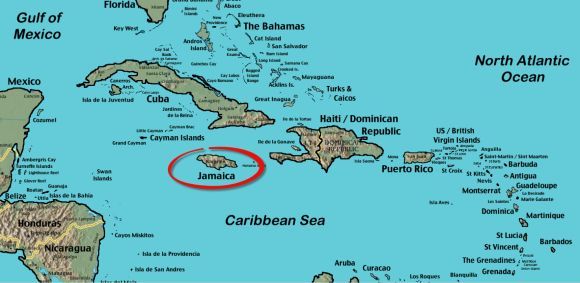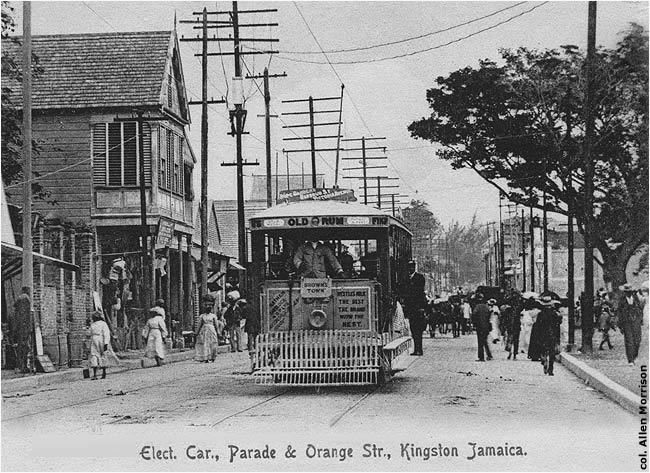When I was first
dating my native-Chicagoan husband, he couldn’t believe I had never had jerk
chicken before. It quickly became one of my favorite foods. And the south side
of Chicago has some of the best places to get jerk chicken. They also served
with it this dense white bread that my husband loves so much (the jerk chicken
places here in Indy that we’ve tried use a cheaper wheat or white bread, and
it’s just not the same—the crumb is too loose). When I told him we were on
Jamaica now, he begged me to find that recipe, and after some research, I found
the recipe for hard dough bread (also spelled with a variety of spellings).
When we got married almost 11 years ago, we wanted to take our honeymoon to
Jamaica, but life got in the way, and we were never able to take a honeymoon
anywhere. And now we have two kids. Maybe one of these days, we’ll all go.
The word Jamaica
comes from its indigenous people, the Taíno people, meaning “Land of Wood and
Water” or “Land of Springs.” Jamaicans themselves often refer to their island
as the “Rock,” and there are many derivatives from this. [Note: this made me
think of the popular drink throughout Latin America called jamaica (or flor de
jamaica), pronounced ha-MY-kah, made
from hibiscus flowers. But as far as I can tell, the name comes the flower
being imported into Jamaica first and then Mexico. However, in the country of
Jamaica, it’s called sorrel; it’s also called bissap among other names in West
Africa.]
Jamaica is an
island nation in the Caribbean. Cuba is to the north, Haiti to the east, the
Cayman Islands to the west, and Panama and Colombia is directly south if you
travel a ways across the Caribbean.
Jamaica has a
tropical climate and is subject to Atlantic hurricanes; it’s been devastated
many times during its history. The island’s tropical climate allows for a
variety of plants and animals that thrive in this climate to make Jamaica their
home. Many kinds of fish, birds, insects, lizards, and other animals are found
here. The good thing is that of the eight types of snakes that are found on the
island, none are poisonous (I personally would treat all snakes as poisonous
and ready to eat me whole, despite its size. But that’s just me.). On the other
hand, Jamaica is home to the Giant Swallowtail, the world’s second-largest
butterfly.
Like other islands
in this area, the Arawak and Taíno peoples were the first inhabitants of
Jamaica. Christopher Columbus landed on the island of Jamaica in 1494 and
claimed it in the name of Spain. The Spanish introduced many crops to the area,
such as sugarcane, a variety of citrus trees, bananas, and others. By the
mid-1600s, the British had taken control and quickly brought in slaves from
Africa to work these fields and within 20 years time, blacks had outnumbered
the white population. During this time, Jews who were banished from their home
areas in Europe saw Jamaica as a refuge and a new start and began pouring into
the country. There were also a number of free blacks on the island as well,
many escaping the US (like they did with the Bahamas). After the British
finally abolished slavery during the early 1800s, they began shipping in Indian
and Chinese workers as indentured servants to work the fields. Although the
British did manage to make some changes in their labor laws (i.e. making it
illegal to beat the workers, etc.), this system of labor more or less lasted
until the middle of the 20th century. There were still several
revolts throughout the 19th and 20th centuries, and the
island remained under British control. By 1962, their efforts paid off, and
Jamaica became its own country. However, it still pays homage to the queen
(like Canada). With their manufacturing industry, their bauxite and aluminum
industries along with tourism, Jamaica began their independence with a strong
economy. However, economic changes for the worse throughout the 1970s and 1980s
caused a tension that forced the country to rely on more foreign investment and
support.
The capital city,
Kingston, is the island’s largest city and located on the southeastern shores
of the island. This city is the largest city south of the United State where
the majority of its people speak English. The harbor this city is situated on,
Kingston Harbour, is the seventh-largest harbor in the world. This large harbor
is probably why it was chosen as the perfect location for a capital city. The
city is home to about 940,000 people and is the center of government, business,
education, sports and has a strong arts and culinary side to their culture. The
British set up many botanical gardens across the island, and this city hosts
several that are still standing.
One of the largest
economic drivers in Jamaica is none other than tourism. Mining is also
important with bauxite and alumina mining forming a significant portion of this
industry. Along with mining, various kinds of manufacturing also employ many
people in businesses such as glass production, construction, beverage
processing, printing, publishing, and software and data (and other technical)
processing. However, Jamaica is also a haven for music production, insurance
underwriting and financial services, and educational services in the Caribbean.
The island is also widely known for its agricultural products such as sugar,
coffee, rum, yams, and bananas.
Because of the
longstanding presence of the British on this island, Christianity remains a
majority religion on this island, and this includes many different
denominations, mostly Protestant. And the interesting thing is that Jamaica has
more “churches” per square mile than any other country in the world. (Chicago’s
south side is probably number two—if it were its own country, that is.) Jamaica
is also mostly identified with the Rastafari movement, which got its start in
Ethiopia and is known for its practices of dredlocks and smoking marajuana. But
because there were many Indian and Chinese workers brought here in the past,
there are also many followers of Hinduism, Buddhism, and Bahá’í as well as
other local indigenous belief systems.
English is the
official language of Jamaica. However, most locals speak a type of Creole
called Jamaican Patois. This patois uses many words from English but has also
incorporated many words from African languages and Taíno (and other indigenous)
languages. Many Jamaican Patois words have spread across the word with the
global popularity of reggae music.
But for this
small-ish island in the Caribbean, Jamaica has a lot to brag about. Jamaica was
the first country to build a railroad in the Western Hemisphere. Not only did
they build it, they built it 18 years before the US did. And this country first
established a postal code in 1688! Jamaica was also the first country to
commercially produce rum. (And I sincerely thank you for it.) Jamaica is known
for its sports stars and has won numerous medals in world competitions. Among
its top performs include Sherone Simpson, Asafa Powell, and Usain Bolt. The
Jamaican bobsleigh team made history and was commemorated in the 1993 movie Cool Runnings. Of all the national flags
in the world, Jamaica’s flag is the only one that doesn’t share any colors with
the US flag. (Yes, I had to look at some flags just to make sure.) But one
thing that remains true is this: this country has a lot to offer, like good
food and good music for starters.
Up next: art and
literature












